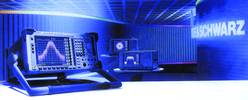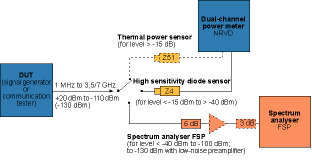Fast and precise measurement of low RF levels
14 March 2001
Test & Measurement
Roland Minihold, Rohde & Schwarz
Some measurements require very low and highly accurate RF levels (typically -100 to -110 dBm), eg for the BER (bit error rate) of digital communication receivers. This R&S test hint summarises how to calibrate extremely precisely, the levels of signal generators and communication testers used for BER measurements.
Rohde & Schwarz' spectrum analyser features measurement uncertainty of 0,5 dB, minimum sweep time of 2,5 ms and up to 30 measurements per second on the IEC/IEEE bus (GPIB). It comes in four models with upper frequencies 3 GHz, 7 GHz, 13 GHz and 30 GHz
Certain digitally modulated signals, such as IS-95 or WCDMA, exhibit a high crest factor. A power meter with a thermal sensor is best suited for determining their levels. For this purpose, Rohde & Schwarz offers the dual-channel power meter NRVD with thermal power sensor NRV-Z51 or NRV-Z52. Due to the limited sensitivity of thermal power sensors, only relatively high levels can be measured (typ greater than and equal to 3330 dBm).
Diode sensors provide comparable measurement accuracy for RF levels down to about -50 dBm due to higher sensitivity. Care should be taken, however, that they are only used in the square law region. Extra measurement uncertainties can occur otherwise in the case of signals with high crest factor or with harmonics. For the high-sensitivity diode sensor NRV-Z4 such effects are negligible in the range -40 dBm ±10 dB.
Figure 1. Suggested test setup to determine small RF levels
The significantly lower RF levels necessary for BER measurements can only be measured with a selective RF receiver or a spectrum analyser. But their absolute measurement uncertainty - even that of a state-of-the art spectrum analyser like the R&S FSP - is higher (0,5 dB) compared to high-quality power meters.
The point of this test hint is to eliminate the absolute error of the FSP spectrum analyser by calibrating it to the dual-channel power meter NRVD with high-sensitivity diode sensor NRV-Z4 for a reference level of approximately -40 dBm (Figure 1). When measuring tiny levels, only the very small linearity error of the FSP that occurs with digital bandwidths adds to the measurement uncertainty of the power meter (Figure 2). Thus a total measurement uncertainty of 0,26 dB can be achieved when measuring a level of -110 dBm.
Figure 2. Linearity error of the FSP spectrum analyser, measured on eight different units (resolution bandwidth 300 Hz)
If necessary, the measurement range can be extended to approximately -130 dBm by means of a low-noise preamplifier. Using the zero span measurement and integration in the (time domain power RMS) of the FSP, the maximum possible measurement speed can be obtained for a given S/N ratio. Application Note 1MA21 provides a detailed description of this procedure and can be downloaded from the Rohde & Schwarz website.
For further information contact Protea Communication & Measurement, (011) 786 3647.
Further reading:
hybridNETBOX instrumentation platform
Vepac Electronics
Test & Measurement
The hybridNETBOX from Spectrum Instrumentation is an innovative instrumentation platform that combines a multi-channel arbitrary waveform generator (AWG) and a digitiser in a single portable unit.
Read more...
14-bit AWG at 20 GS/s
Vepac Electronics
Test & Measurement
The Arb Rider AWG-7000 is the world’s fastest 14-bit Arbitrary Waveform Generator, featuring a 20 GS/s real time update rate and 14-bit vertical resolution.
Read more...
Additions to APD5000 series oscilloscopes
Osiris Technical Systems
Test & Measurement
Each unit is equipped with an integrated CAT II digital multimeter, three programmable power supplies, a dedicated trigger line, and an arbitrary waveform generator.
Read more...
Handheld RTSA up to 9,5 GHz
Vepac Electronics
Test & Measurement
The PXE-90 implements an FFT engine on the built-in FPGA and support frame compression with trace detection while ensuring no missing samples between FFT frames.
Read more...
InterCal introduces a new range of calibrators
Intercal
Test & Measurement
Calibration is a critical process in numerous industries, from manufacturing to healthcare, ensuring that instruments and devices provide accurate and reliable measurements.
Read more...
Power Energy Meter for solar projects
Mimic Components
Test & Measurement
The Mi550 Power Energy Meter is a handheld three-phase power quality analyser that connects externally with Rogowski coils or voltage-type CTs, allowing for testing without disconnection.
Read more...
MT8870A for NTN NB-IoT testing
Tamashi Technology Investments
Test & Measurement
Samsung Electronics has selected the Anritsu Universal Wireless Test Set MT8870A for use on the mass-production lines of the Galaxy S25.
Read more...
XJLink-PF40 JTAG controller
ASIC Design Services
Test & Measurement
XJTAG, a specialist in electronic testing, has released its new XJLink-PF40 JTAG controller together with version 4 of its popular PCB software testing suite.
Read more...
INTEGRA Biosciences’ reagent dispenser now supports SiLA-2 integration
Test & Measurement
This new functionality will make it even easier to integrate the WELLJET into automated laboratory workflows, helping labs to enhance their productivity and reproducibility.
Read more...
Advanced portable spectrum analyser
Vepac Electronics
Test & Measurement
HAROGIC has introduced the SAE-200, a USB-based real-time spectrum analyser that operates from 9 to 20 GHz with a 100 MHz bandwidth.
Read more...



